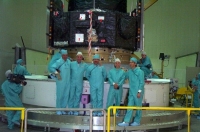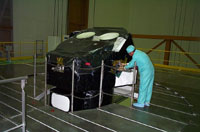Integration with Launcher
26 November 1999
The XMM spacecraft today stands successfully installed at the summit of Ariane 504. The mating took place, as scheduled on 25 November. This important operation directed by Philippe Kletzkine and Daniel de Chambure from the ESA XMM Project team greatly impressed all those involved and a few very privileged spectators.The spacecraft, mounted on its payload adapter, was first transferred on an air-cushion pallet from the preparation zone of the Final Assembly Building to the bottom of the hoisting shaft area.
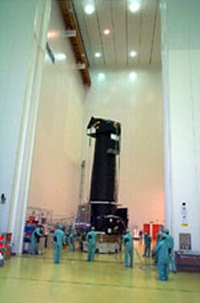 |
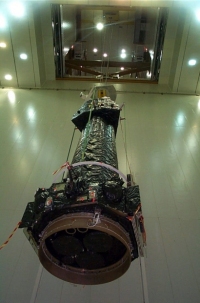 |
|
XMM on its air-cushion platform is moved to the base of the hoisting shaft. |
A slow ride up to a special rendez-vous! |
The vertical lifting device was attached to eight brackets (4 at the top of the spacecraft and 4 on the service platform). XMM was then raised to a height of over 60 metres, a slow ride up taking some 20 minutes.
Under the gantry crane at the top of the shaft, XMM was then moved laterally through an opening into the launcher side of the Final Assembly Building. It was passed over the two uppermost service platforms, and back down to the payload platform.
At this level (to which the telescope sun shield had previously been brought), XMM was centred with respect to the launcher, and lowered extremely slowly the last remaining 30 cm. For the last few centimetres, guiding pins located around the launcher interface allowed a perfect mating of the payload adapter to Ariane 5. XMM was sitting in place on the vehicle at 9:20 am Kourou time. Like a king on its throne.
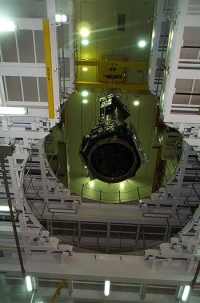 |
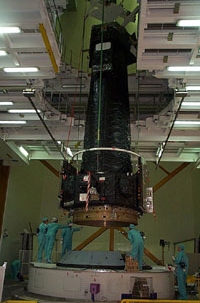 |
|
XMM is lowered towards the launcher | |
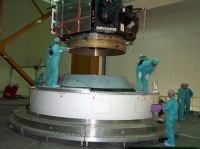 |
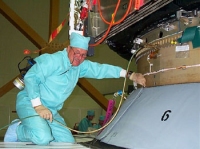 |
|
XMM is put in position on top of Ariane 504 launcher |
Jurgen Straub places a symbolic first bolt |
Operations continued with the fastening of the payload adapter to the launcher interface. It took four members of the staff from Arianespace and the Guiana Space Center over an hour to position and carefully fasten the 360 bolts. One member of the Dornier team, Jurgen Straub, symbolically helped by placing one of them.
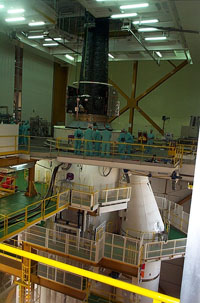 |
|
Wide view showing XMM on its launcher with, beneath the payload platform, Ariane 5's main stage and the top of its solid propellant boosters. |
The mating constituted one of the last milestones in the satellite campaign. Operations in the cathedral-like building highlighted the grandiose endeavour of this mission and its launch: Europe's largest ever science satellite on its biggest launcher. As people saw the two come together, emotions were high. Even members of Dornier's "mechanical gang" such as Reinhold Rebholtz, with many previous space missions under their belts, were greatly impressed. They had been working years to see this moment. Cameras snapped away for the souvenir photographs.
But there was little time to relax. The lifting devices were removed from the spacecraft. This job required accessing the attachment points from two mobile platforms that were delicately positioned around the spacecraft.
After a final verification, the Dornier "mechanical gang" happily left the payload platform to their colleagues who had to pursue the spacecraft's preparation on top of the launcher. These activities include closing all the thermal insulation, removing red-tag items, establishing the radio-frequency links and switching the spacecraft on for the first time on the launcher.

